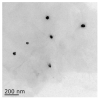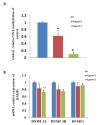Graphene Oxide-Silver Nanoparticle Nanocomposites Induce Oxidative Stress and Aberrant Methylation in Caprine Fetal Fibroblast Cells
- PMID: 33808775
- PMCID: PMC8003532
- DOI: 10.3390/cells10030682
Graphene Oxide-Silver Nanoparticle Nanocomposites Induce Oxidative Stress and Aberrant Methylation in Caprine Fetal Fibroblast Cells
Abstract
Graphene oxide-silver nanoparticle (GO-AgNPs) nanocomposites have drawn much attention for their potential in biomedical uses. However, the potential toxicity of GO-AgNPs in animals and humans remains unknown, particularly in the developing fetus. Here, we reported the GO-AgNP-mediated cytotoxicity and epigenetic alteration status in caprine fetal fibroblast cells (CFFCs). In brief, the proliferation and apoptosis rate of GO-AgNP-treated CFFCs (4 and 8 µg/mL of GO-AgNPs) were measured using the cell-counting kit (CCK-8) assay and the annexin V/propidium iodide (PI) assay, respectively. In addition, the oxidative stress induced by GO-AgNPs and detailed mechanisms were studied by evaluating the generation of reactive oxygen species (ROS), superoxide dismutase (SOD), lactate dehydrogenase (LDH), malondialdehyde (MDA), and caspase-3 and abnormal methylation. The expression of pro- and anti-apoptotic genes and DNA methyltransferases was measured using reverse transcription followed by RT-qPCR. Our data indicated that GO-AgNPs cause cytotoxicity in a dose-dependent manner. GO-AgNPs induced significant cytotoxicity by the loss of cell viability, production of ROS, increasing leakage of LDH and level of MDA, increasing expression of pro-apoptotic genes, and decreasing expression of anti-apoptotic genes. GO-AgNPs incited DNA hypomethylation and the decreased expression of DNMT3A. Taken together, this study showed that GO-AgNPs increase the generation of ROS and cause apoptosis and DNA hypomethylation in CFFCs. Therefore, the potential applications of GO-AgNPs in biomedicine should be re-evaluated.
Keywords: caprine fetal fibroblast cells (CFFCs); epigenetic; graphene oxide; reactive oxygen species (ROS); silver nanoparticles.
Conflict of interest statement
The authors declare no conflict of interest.
Figures












Similar articles
-
Cytotoxicity and Transcriptomic Analysis of Silver Nanoparticles in Mouse Embryonic Fibroblast Cells.Int J Mol Sci. 2018 Nov 16;19(11):3618. doi: 10.3390/ijms19113618. Int J Mol Sci. 2018. PMID: 30453526 Free PMC article.
-
Combination of graphene oxide-silver nanoparticle nanocomposites and cisplatin enhances apoptosis and autophagy in human cervical cancer cells.Int J Nanomedicine. 2017 Sep 5;12:6537-6558. doi: 10.2147/IJN.S125281. eCollection 2017. Int J Nanomedicine. 2017. PMID: 28919753 Free PMC article.
-
Quercetin-mediated synthesis of graphene oxide-silver nanoparticle nanocomposites: a suitable alternative nanotherapy for neuroblastoma.Int J Nanomedicine. 2017 Aug 16;12:5819-5839. doi: 10.2147/IJN.S140605. eCollection 2017. Int J Nanomedicine. 2017. PMID: 28860751 Free PMC article.
-
Silver nanoparticles: Electron transfer, reactive oxygen species, oxidative stress, beneficial and toxicological effects. Mini review.J Appl Toxicol. 2019 Jan;39(1):16-26. doi: 10.1002/jat.3654. Epub 2018 Jun 25. J Appl Toxicol. 2019. PMID: 29943411 Review.
-
Silver nanoparticle-induced oxidative stress, genotoxicity and apoptosis in cultured cells and animal tissues.J Appl Toxicol. 2013 Feb;33(2):78-89. doi: 10.1002/jat.2792. Epub 2012 Aug 31. J Appl Toxicol. 2013. PMID: 22936301 Review.
Cited by
-
Cytotoxicity of Metal-Based Nanoparticles: From Mechanisms and Methods of Evaluation to Pathological Manifestations.Adv Sci (Weinh). 2022 May;9(16):e2106049. doi: 10.1002/advs.202106049. Epub 2022 Mar 27. Adv Sci (Weinh). 2022. PMID: 35343105 Free PMC article. Review.
-
The Neurotoxic Mechanisms of Graphene Family Nanomaterials at the Cellular Level: A Solution-based Approach Review.Curr Pharm Des. 2022;28(44):3572-3581. doi: 10.2174/1381612829666221202093813. Curr Pharm Des. 2022. PMID: 36464882 Review.
-
The Effect of Nanomaterials on DNA Methylation: A Review.Nanomaterials (Basel). 2023 Jun 17;13(12):1880. doi: 10.3390/nano13121880. Nanomaterials (Basel). 2023. PMID: 37368308 Free PMC article. Review.
-
Silver nitroprusside as an efficient chemodynamic therapeutic agent and a peroxynitrite nanogenerator for targeted cancer therapies.J Adv Res. 2024 Feb;56:43-56. doi: 10.1016/j.jare.2023.03.005. Epub 2023 Mar 22. J Adv Res. 2024. PMID: 36958586 Free PMC article.
-
Sodium dodecyl sulfate-coated silver nanoparticles accelerate antimicrobial potentials by targeting amphiphilic membranes.mLife. 2024 Dec 3;3(4):551-564. doi: 10.1002/mlf2.12143. eCollection 2024 Dec. mLife. 2024. PMID: 39744089 Free PMC article.
References
Publication types
MeSH terms
Substances
Grants and funding
LinkOut - more resources
Full Text Sources
Other Literature Sources
Research Materials
Miscellaneous

